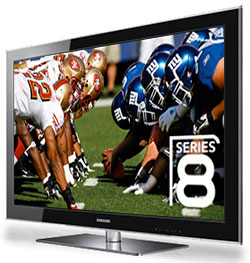
Dick De Jong
February 12, 2010
HDTV Solutions
I say this with all due respect to you, dear readers. The Samsung PN50B860 may be too much for you to handle. And I mean no disrespect to this wonderful 50" plasma HDTV that I would be delighted to have in my man cave.
Simply, this Series 8 1080p beauty is overflowing with features, like Internet widgets, a Content Flash Library and DLNA connectivity, that many of you traditionalists would never use, especially if you don't plan on hooking your TV into your home network.
With that said, I don't wish to deter you from considering Samsung's 2009 top of the line model. The picture quality of the PN50B860 reaffirms the golden reputation that plasmas have earned over the years.
If you are worried that the TV is too complicated to operate, the designers have done an admirable job of stowing away all the bells and whistles so that you will never encounter them if you just want to sit back and enjoy the Olympics or the last season of LOST.
Please note that for all of its state of the art components, the PN50B860 came out last year and is not 3D capable. We won't be seeing 3D TVs available to buy in the U.S. for at least another month or two.
(Editor's Note: Samsung also makes a 58" version of the 860 series, the PN58B860. Since it has similar specifications, this review of the PN50B860 can apply to it also.)
In the HDTV family tree, plasmas have been considered the chunky monkeys when compared to their skinny minnie LCD cousins. But in the last couple of years plasmas have become much more diet conscious.
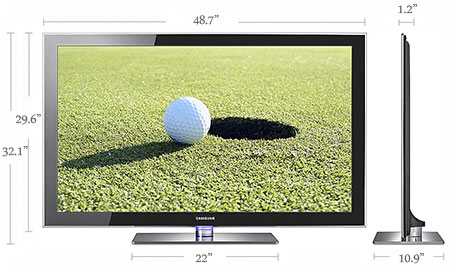
As a prime example of a Biggest Loser, this 50" plasma measures only 1.2" (30mm) deep and weighs only 57.5 pounds without the stand. The brushed stainless steel surface stand adds another 14 pounds, but it allows you to swivel the TV left or right about 30 degrees.

This TV sports Samsung's Touch of Color design. Though in a dimly lit room, I have a hard time finding the "stylish gray tone" inside the clear border around the frame. It's just too subtle. The same can't be said about the neon blue light that illuminates the clear acrylic neck of the stand. If it's too disco for you, go into the Setup menu and turn off the Light Effect.

When the TV is turned off, the black screen is reflective, but Samsung touts an "Ultra FilterBright Plus" technology, which does effectively negate most glare problems when the TV is on.
Being only an inch thick doesn't leave a lot of room for connectors, but Samsung indents the left side of the back of the TV with two sets of plugs.
The layout can make attaching bulky HDMI cables difficult, if not impossible. The manual designates that the maximum thickness of the HDMI cable cannot be over .55" or 14mm.
Running vertically, the first panel contains four HDMI inputs, two USB ports (for uploading JPEG photos, MP3 songs or MPEG videos), an analog Audio Out (stereo minijack), an SPDIF (optical) digital Audio Out, an Audio In (stereo minijack), and an Ex-Link (for Service).
Next to this panel on the back, running horizontally with the connectors facing down, a second panel holds one VGA PC input and one Component video (YPbPr) In (with matching stereo Audio In).
You could also use the Y plug to input Composite video. (Though it eludes me why in the world you would want to sully this pristine screen with Composite dreck.)
The one RF antenna connector links to integrated ATSC/QAM tuners. Since the tuner system is Clear QAM compatible, you can attach your cable TV signal directly into the RF connector and tune in unscrambled cable stations.
For those concerned about the DTV transition, the ATSC tuner is the key. With the proper antenna, you will be able to tune in digital signals broadcast over-the-air.

Also supplied is a LAN port for directly connecting to the Internet and your home network. Since this TV does not come with any sort of keyboard - only a couple of TVs do - access to Internet content comes through widgets, little icons that appear on-screen.

Samsung's widget gallery is constantly expanding beyond the standard news, weather, finance, and sports choices supplied by Yahoo.
As I browse the options on this TV, I find widgets for TV Guide, Funspot (games like Texas Hold'Em), Blockbuster, YouTube, flickr, Amazon Video on Demand, eBay, and Twitter.
Remember that without a keyboard, don't expect the same experience as surfing the web on your computer. The responsiveness of the remote is often glacier-like, painfully slow.
Also, if you plan on streaming TV shows or movies from sites like Blockbuster or Amazon and you are serious about obtaining good picture quality, you will need fairly fast and robust bandwidth from your Internet provider, ideally around 10Mbps.
I know some sites suggest as low as 2.5Mbps, but if anyone else in your house is accessing the network, the video playback will deteriorate. At least try to have around 5Mbps.
In addition to the widgets, Samsung has built into the TV 500Mb of memory which holds a Content Flash Library of preloaded programs. Press the Content button on the remote control, and you can choose from four categories, Gallery, Cooking, Children and Wellness.
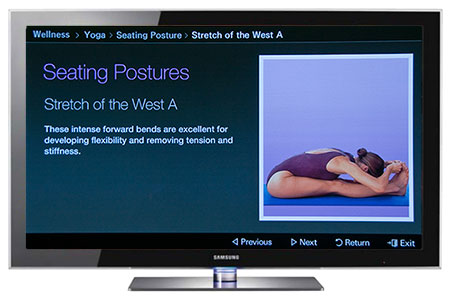
The programs are in a slide show format. For example, the recipe for Caesar Salad in the Cooking section starts on the first page with a colorful close-up image with the ingredients listed on top. The next page is the first step in the recipe.
Browsing through the choices I was impressed with the production level and the utility of the information. Samsung even offers more content that you can download directly from their website into the TV's internal memory.
You can transfer photos, music and video to the TV from a flash drive plugged into one of the USB ports. But if the files are on your computer, a more efficient method is to hook up your TV through the LAN port into your home network. You can then tap into the folders on your computer directly from the TV menu.
The setup is fairly straightforward, but a passing familiarity with DLNA (Digital Living Network Alliance) configurations would be helpful.
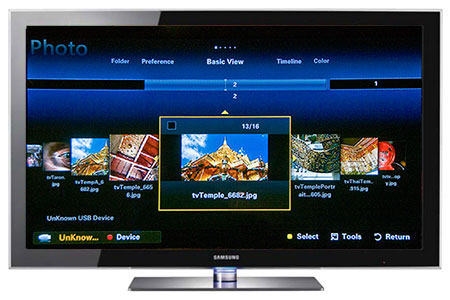
Whichever method you employ to view your photos on this TV, I can't oversell the thrill of seeing your images illuminated on this 50" display. The Slideshow interface is pretty good. You only have three speeds, but nine transitions from simple Fades to dizzying Spirals. You can also add music. I especially appreciate the ability to adjust the Picture Settings while looking at the images.
The PN50B860 does supply Picture-in-Picture. But like most TVs that do, you are limited in your picture combinations. One of the sources always must be from the internal TV tuner. For example, you cannot pair two HDMI sources.

Once again, the Samsung designers have curved the handle of the quick draw remote control so that it fits into your palm more comfortably. Which is good because this long glossy black remote is a handful, jam-packed with buttons for specific tasks like opening the Media Player or summoning the Internet widgets.
The black titles stenciled on the white buttons are easy to read and the backlight turns on behind every button when any one of them is pushed.
One fun feature is the Light button on the remote. It turns a gyro function on and off. When it's On, the remote will light up when you pick it up or otherwise move it, good for late night channel surfing. When the function is off, the remote only lights up when you press a button.
As I mentioned most of the fancier features don't clutter up your basic TV watching screen. But when you are ready to experiment with extras like widgets, (which Samsung labels Internet@TV), then both on-screen and written materials are provided to guide you through the setup process.
The EPA is now publishing a list of ENERGY STAR qualified TVs. (You can find it here.) The Samsung PN50B860 is on the list.

The EPA states that this Samsung's On Mode Power is 247W and Standby Power Consumption is .22W. Based on the formula that the TV is on five hours a day and in Standby for the other 19, the Estimated Annual Energy Use is 452 kWh/year.
You need to check your electric bill to see how much you are paying for a kWh. The rate that I have been using in previous reviews is 10.4 cents. Doing the multiplication, at that rate, the yearly energy cost is $47.01.
Since manufacturers are not attaching those yellow ENERGY STAR tags that you find on air conditioners and refrigerators, you will have to study the ENERGY STAR list to see how the PN50B860 compares to other 50" TVs.
Just glancing at other Samsung models on the list, I see that some of the 55" LCDs consume less that half the power that this smaller plasma does.
The difference between paying about $2 a month for the more power efficient LCD compared to $4 for this plasma might not seem that significant to your pocketbook. But when you consider that there are millions of TVs in America, the extra energy consumption adds up quickly.
To calibrate the TV, we use two discs, the Blu-ray version of the Digital Video Essentials DVD called HD Basics and the Spears & Munsil High Definition Benchmark Blu-ray DVD. We are playing the DVDs on the OPPO BDP-83 Blu-ray player connected to the HDTV with an HDMI cable.
We use the test patterns to adjust black level, white level, and color bias. The player is set to output a 1080p signal, which is the native resolution of the PN50B860.
To begin, I followed my usual pre-calibration routine. First, I choose a Picture Mode. On the PN50B860, Samsung provides four choices: Dynamic (Vivid), Standard, Eco and Movie.
When reviewing other Samsungs, I was told by one of their technical representatives that the "Movie mode is geared towards providing the most accurate image. The Warm2 color tone is calibrated to be closest to D6500, the most accurate color temp."
If you want to make your life easier, put on your favorite program and set the mode to Movie. It might not look right at first, but give yourself a few minutes to adjust. If you still feel antsy, try the Standard mode.
The majority of people fall in one of those two camps or somewhere in between. Usually, you can find your comfort zone with a few minor tweaks.
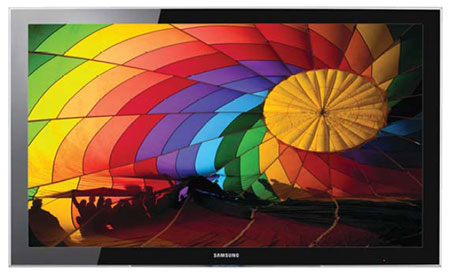
Of course, if you want to satisfy an urge to push all the buttons before you settle in - and the PN50B860 gives you a pile of settings to play with - then follow along. Though I'll wager that by the time you are finished futzing, you'll be very close to one of these two presets. I wouldn't make that bet with every brand of TV, but Samsungs are pretty consistent.
Off we go then. For reference, I leave Movie mode untouched and fiddle with Standard. With this TV, that choice has an immediate consequence because my next step is to pick a Color Temperature.
On the PN50B860, it's called Color Tone, which is found in the Picture Options sub-menu. In Standard mode, the only choices are Cool and Normal. The Warm choices are grayed out. Warm1, Warm2, and Warm3 are only available if you picked Movie mode.
Therefore if you favor the reddish, yellowish Warmish look, then you should be tweaking Movie mode. I picked Standard originally because the Movie preset is just a little too warm for me. I'm sticking with Standard and choosing Normal for Color Tone.
With that settled, I usually start by turning down the Backlight to about halfway. But this is a plasma and Backlight is normally a term used for LCDs. On this plasma there is a Cell Light setting.
I quote from a setup document that I received from Samsung Tech Support, Cell Light "lowers the power usage of the TV. Lowering the Cell Light setting will decrease the set's APL limiting threshold, which essentially reduces the peak light output on high-APL (full-field) content. This will have no effect on the black level, and ultimately has little effect on the picture. We suggest increasing the backlight to 10 and leaving it there."
Being a bit of a rebel and a tree hugger, I left the Cell Light at 5. The choice is yours.
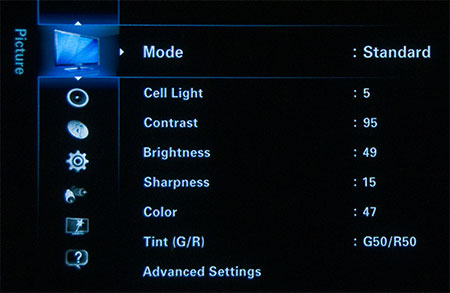
Next, I go into the Advanced Settings sub-menu and turn everything off, like Black Tone, Dynamic Contrast, Gamma, Flesh Tone, and Edge Enhancement. Once you work through the basic picture settings, you can return to this menu and experiment.
Going back to the main Picture Settings menu, according to the test patterns, I pushed Brightness up a few notches from the default of 45. I left Picture (Contrast) at 95. Color (Saturation) was lowered to 47 I'll talk about Tint in a second.
The Sharpness scale runs from 0 (Min) to 100 (Max). When looking at a Safe Zone test pattern, I noticed the beginning of fringing above 20. i don't like artificially sharp images, therefore I dropped it to 15. You can adjust Sharpness higher if you prefer living on the edge.
I then played some of the reference scenes and the picture looked dandy except for skin tones being a little too red for my eye. I've come to realize that a TV set up according to test patterns often is too red for me.
The question then becomes, which setting do I tweak? Flesh Tone would seem like a good place to start, but it didn't give me the result I was looking for. I tried sliding Tint towards Green and away from Red, but I'm even less of a fan of greenish tints. I finally settled on lowering the Red saturation a bit in the Color Space menu after picking Custom.
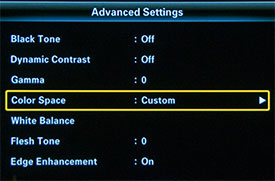
If you feel that you need to fiddle further, there are plenty of Advanced Settings to try. As always, I suggest that you tune one control at a time. The Tech Support document states that for Black Tone and Dynamic Contrast, "Off is the most accurate setting." And Auto is the most accurate default color space. If you get too far afield, you can always Reset to default settings.
One last point, if you look in the Picture Options sub-menu, under Film Mode, you'll find a Cinema Smooth setting. It's only applicable if you are feeding your PN50B860 a 1080p 24Hz HDMI signal, the type you would receive from a Blu-ray player. If you turn on Cinema Smooth, then the TV multiplies the 24p content four times to create a 96 Hz output with no 3-2 judder or flicker. Next time you are watching a Blu-ray movie, try it and see what you think.
The Samsung PN50B860 reinforces why I love plasmas. The picture quality is top notch. Blacks are deep and silky smooth, the colors flow like satin. The visual experience is almost tactile as if you can feel the texture of the reds and blues.
If you have been caught in the 240Hz whirlpool of hype that is surrounding LCDs, I watched the Super Bowl on this plasma and the PN50B860 handled every fast motion scene thrown at it, even when Tracy Porter flew down the field with his interception.
I wish I could be as enthusiastic about the audio performance of the pair of integrated 15W speakers. A perfect example of the disparity between audio and video is revealed when I spun the K.D. Lang Live in London Blu-ray concert.
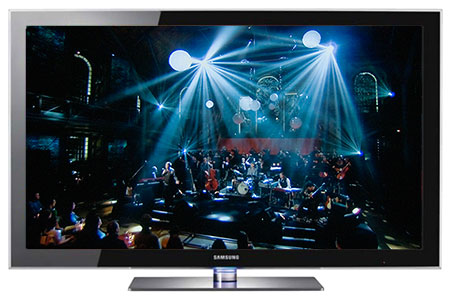
The staging with the volumetric lighting was gorgeous as K.D. glided around barefooted. Hallelujah! The sound coming from the TV was a disconnect as it couldn't capture her dulcet voice backed by the BBC Concert Orchestra. Constant Craving!
I have the TV hooked up to a sound bar, but to really match the picture quality of this plasma, you should invest in a more worthy 5.1 or 7.1 surround system.
The PN50B860, Samsung's 2009 top of the line, 1.2" thin, plasma HDTV supplies superior picture quality and a multitude of connectivity features that make it a great choice as the centerpiece of a home media network.
Posted Aug 20, 2014 10:01:04 AM
By Kyle
Thanks.